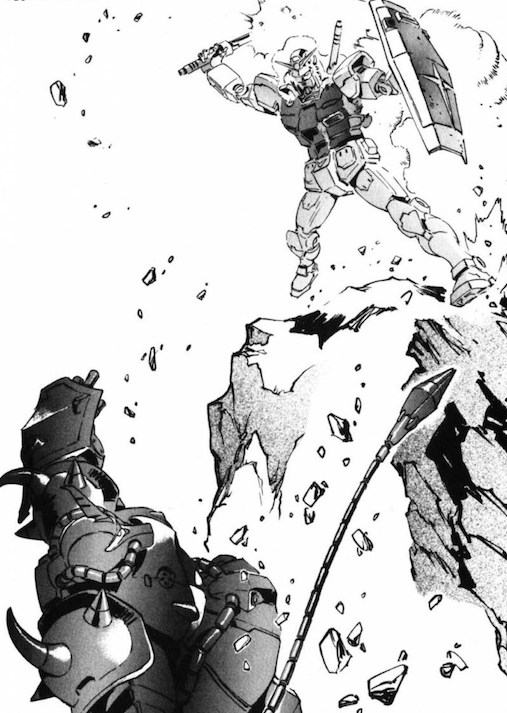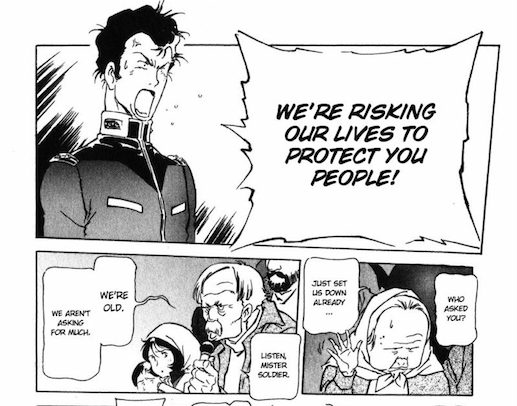by Adam Pelta-Pauls
My first exposure to Gundam was probably similar to many of yours, as a child of the early 90s. I sat down to watch Toonami after school one day, and suddenly found myself involved in the lives of five ostensibly-international teenagers, each with his own giant robot, known as a “mobile suit.” This was Gundam Wing and it was, well, pretty insane. Wing, whose full title is New Mobile Report: Gundam Wing, is a ways down the line in the chronology of Gundam shows, which means the series was less plot and more about moving plastic model kits off shelves. A pretty straightforward action show with giant robots, Michael Bay-esque set pieces, and the world’s worst love interest, it’s a far cry from what the first Gundam show was all about.
The Gundam franchise celebrated its 35th anniversary last month as April 7th marked the date in 1979 that the first episode of the first series, Mobile Suit Gundam, aired in Japan. Anime pioneer Yoshiyuki Tomino, who created MSG, has a reputation in Japan similar to that of George R.R. Martin, in that he’ll kill off characters on a whim. That series was fairly revolutionary for its time, featuring a huge ensemble cast, arc-based storytelling, and a plot that asked deep philosophical questions about humanity’s future. Since then, it’s become a cultural icon for the country, even spawning the first academic institution based entirely on a television series, the International Gundam Society.
Mobile Suit Gundam’s story concerns the One Year War, which takes place in the year 0079 of the Universal Century calendar. We stopped using AD in 2045 to mark the date when we began shuttling people offworld, into to a vast network of space colonies around Earth. Each colony group, known as a “Side,” sits at one of five Lagrange points, real-life areas of stable gravity in the orbit between Earth and the Moon. When the series opens, nine months have passed since the colonies at Side 3 renamed themselves the Principality of Zeon and declared independence from the Earth Federation government. Since then, the crossfire between the two factions has claimed the lives of half of humanity’s population and the conflict has entered a prolonged stalemate.
See, both Zeon and the Federation have mobile suits in their armies, but Zeon developed them first. Their mainstay unit, the Zaku II, is a much better machine than anything the Federation has fielded so far. That is, until the Federation decides to step up its MS game. They begin “Project V” at a secret R&D lab in Side 7, creating the Gundam, a prototype advanced frontline-combat mobile suit. Unfortunately, just as the Gundam is in its final testing phase, Side 7 is infiltrated by a Zeon strike force, led by ace pilot Char Aznable.
This brings us to Mobile Suit Gundam: THE ORIGIN, a comic book adaptation of the original anime series reimagined by Yasuhiko Yoshikazu, the series’ original character designer. To call it an adaptation, though, seems limiting, considering what the book really is. The original anime series hasn’t aged terribly well. It came out during the nascent years of Japan’s early-80’s robot craze, and it bears some of the weirder hallmarks of the genre (the G-Fighter is an excellent example of this phenomena). It also has weird tonal issues, points where it jumps the spectrum from sight gags and easy sex jokes to deep, personal drama in seconds, often without payoff. Yoshikazu’s version cleans up the series in many ways: altering the history slightly, making the Earth Federation and Zeon more evenly matched, and swapping the order of several story points and increasing the drama considerably. He even adds an extended flashback, lasting 1200+ pages, filling in a decade’s worth of backstory for the series.
In effect, Mobile Suit Gundam: THE ORIGIN offers a revamped take on the story of the original anime that’s all thriller, no filler. Gone are the more trivial encounters throughout the flight of White Base, leaving the story a trim, well-paced affair, focused on what made it memorable in the first place: the characters. What you walk away with from every volume is a visceral sense of how this war is affecting each character on a personal level.
Yoshikazu’s art is what makes the series so enchanting. He does all his work freehand, an astonishing feat, and his style has a wonderful vintage flair. Most of the art in the book is in black and white, and Yoshikazu’s careful linework and use of white space really shines in this format. The action sequences are clean and well-choreographed, so mech fights lack the ball-of-metal confusion of Transformers. Even conversations shine, dramatically. On the first and sometimes last few pages of a chapter, the artwork is enhanced in delightful watercolor.
Several of the covers to the fantastic Vertical Publishing hardcover releases (Volume Five came out in March, and Six will be out in June) have brilliant paintings of the main characters and events on their front. Vertical’s hardcovers retain the original right-to-left format from the Japanese release, but the artwork leads the eye naturally. If we’re nitpicking, the translated dialogue gets broken up between speech bubbles pretty awkwardly, but after a few chapters, readers used to Western comics won’t even notice they’re reading a book “backwards.”
The original late-70s styling for the characters still holds up, too, after all these years: men are slim and handsome, women are graceful and delicate. There’s no fan-service, no oversized anime boobs, and while some tonality issues persist, all the remaining sex jokes are used to empasize the immaturity of younger characters.
Although all of the characters are wonderful, it’s the bad guys that are the real treat of THE ORIGIN. The powerful Zabi family (Degwin Sodo Zabi and his four children) rules the Principality of Zeon. Each Zabi is different, with wildly varied motivations, and the family’s infighting is a big feature of the series. The crew of White Base also run into many different Zeon commanders, like the conniving M’Quve, the brazen Garcia Romeo, and the noble Ramba Ral. Each enemy is unique and challenges the White Base crew in new ways, but they’re also memorable long after the book has moved on from their stories. Ramba Ral is far and away my favorite character in the series, and I often reread the volume he’s in, just because he’s such a great enemy for Amuro Ray, the series’ protagonist, and pilot of the eponymous Gundam.
Tomino loves the trope of the unwilling soldier: characters thrown into a conflict they wanted no part of until some outside force swept them up into it. Identity, especially discovering/creating one’s own, is a big theme in the series, and it’s one of the more interesting stories told in the book. Much of the main “good guy” cast of Gundam struggles for identity, Amuro most of all. His coming-of-age and rise to fame becomes our window on the One Year War, though it’s the interplay between characters that makes the story so fascinating.
At the outset, there are already rumors in the Zeon army about the Federation’s new battleship, White Base, which the soldiers dubbed the “Trojan Horse” because of its nature as a secret weapon to turn the tide of the war. After its first few skirmishes, the soldiers begin talking about the Trojan Horse’s own secret weapon, an unstoppable white mobile suit. As readers, we see these rumors affect the morale of the Zeon army. News of the Trojan Horse and its “White Devil” reaches the ears of the Zeon soldiers well in advance of its appearance, usually leading their commanders to reckless acts in order to control their troops.
In actuality, the man inside the “White Devil” is 15-year-old Amuro Ray. Amuro begins the series as a pretty hateful little jerk, and after several chapters with him you actually begin to question why he’s been introduced to you as the protagonist. He sucks. Amuro’s first successes on the battlefield are almost all accidents, and he pisses people off with his cockiness left and right. He’s frustratingly moody and stubborn, and he takes his friends for granted. By the time you meet Char, who is slicker, smarter, and better than Amuro in almost every way, you can’t help but root for him a little against the bumbling newbie. But, as the series progresses, the audience bears witness to every one of Amuro’s formative experiences. You see him slowly begin to earn his victories with skill and finesse. You watch the war force Amuro to mature, and you see every way that it shapes him into a man finally worthy of his legend.
Mobile Suit Gundam has been a passion of mine for a pretty long time, but it’s not always an easy passion to share. Admittedly, the story has flaws and inconsistencies, but I kind of love it all the more for those. Mobile Suit Gundam: THE ORIGIN, though, is my passion, validated. It’s something I can really feel proud to be a fan of, and something I’m glad to share with a wider audience. Mobile Suit Gundam was a mecha action show that wanted badly to be a complex drama. THE ORIGIN finally allows it to do that. At long last, it’s Gundam worth a serious discussion.
Deadshirt contributor Adam Pelta-Pauls is an exiled American currently lost in Cardiff, Wales. You can find him on Twitter at @Neochiiz3000.




